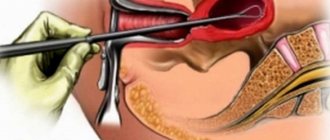There are two methods of vacuum aspiration (also called suction aspiration).
- Manual vacuum aspiration
. This procedure can be used approximately 5 to 12 weeks after your last menstrual period (early first trimester of pregnancy). It involves using a specially designed syringe to perform suction. This method is not available everywhere, but may be more affordable than machine suction in some geographic areas. - Machine vacuum aspiration
. This procedure is a common method used in the first 5 to 12 weeks (first trimester) of pregnancy. Machine vacuum aspiration involves the use of a hollow tube (cannula) that is attached to a bottle and a pump that provides a gentle vacuum action. The cannula is inserted into the uterus, the pump is turned on, and the tissue is gently removed from the uterus.
Consequences after a vacuum abortion
As mentioned above, performing an abortion by absolutely any method, including vacuum, is a great stress for the woman’s entire body. There are many symptoms that may bother a woman after an abortion. These symptoms can be called negative consequences - complications.
Complications after a mini abortion - symptoms may vary. After aspiration, bloody discharge may occur. This type of clinical manifestation is a normal reaction of the body. Most women think that this is menstrual discharge, but this is wrong. This type of discharge should be no more than two weeks from the date of the procedure. As for the abundance, it should gradually decrease.
If blood is released with other accompanying clinical manifestations, then this is no longer normal. Such symptoms may include pieces of blood clots, stabbing pain, and massive bleeding. If all this happens to a woman, then she needs to urgently seek medical help.
As for pain as a symptom of complications after a mini-abortion, they can often be observed. They should not exceed 5 days. If the pain does not decrease in intensity and severity, then the alarm should be sounded. As for edematous phenomena, they are also normal in the first three days.
Menstruation appears after an abortion and can occur in different ways, but the nature of this process will not be any different. The first menstruation after a vacuum abortion is most often extremely scanty and not abundant. If your period does not appear for any reason, you should immediately contact your doctor.
Also, if a woman does not have her period, it is necessary to conduct a special pregnancy test. If a positive result is revealed, it means that the previously performed vacuum abortion was performed unsatisfactorily. In some cases, this may be a pregnancy outside the uterine cavity or other consequences after a vacuum abortion.
If the result is negative, then you need to wait a while and do the test again.
conclusions
To quickly restore the uterus and reduce the risk of complications, a woman should follow all the doctor’s recommendations, as well as undergo a timely follow-up examination and ultrasound after an abortion. All this will help preserve the reproductive system for bearing and giving birth to a child in the future.
MAKE AN APPOINTMENT
Abortion and contraception clinic in St. Petersburg - department of the medical gynecological association "Diana"
Make an appointment, tests or ultrasound via the contact form or by calling +8 (812) 62-962-77. We work seven days a week from 09:00 to 21:00.
We are located in the Krasnogvardeisky district, next to the Novocherkasskaya, Ploshchad Alexander Nevsky and Ladozhskaya metro stations.
The cost of a medical abortion in our clinic is 3,300 rubles. The price includes all pills, an examination by a gynecologist and an ultrasound to determine the timing of pregnancy.
Complications after mini abortion
Of all the methods of abortion, this type of abortion is the safest. After this method, there are minimal cases of complications and other negative consequences. But still, the most common consequences after termination of pregnancy (mini-abortion) can be the following:
- Perforation processes of the uterine walls. A rare occurrence is damage to the uterus by dilatation.
- Processes of spasm in some areas of the uterus. In this case, febrile temperature and acute pain may occur.
- Insufficient and defective removal of the fetus. These egg particles can cause hyperthermic syndrome, dagger pains and general intoxication of the body.
- Pregnancy outside the uterus. That is, after the procedures performed, it turns out that there was a fetus in the tubes that was not previously detected. Surgery is necessary.
After an abortion, it is necessary to be constantly in a normal psychological state, without any stress or other disturbing factors.
Why is anesthesia needed?
Vacuum surgery is considered less traumatic than conventional surgery. However, it does involve some painful manipulation. This:
- expansion of the uterine muscles;
- “sucking out” the fertilized egg with its subsequent separation;
- removal of the instrument from the uterus.
The most unpleasant sensations are those that occur when the entrance to the uterus expands. The operation lasts 10-15 minutes, but so that the woman does not feel pain, the doctor offers anesthesia - local or general.
FAQ
Why is a vacuum prescribed after childbirth? In fact, there are several possible reasons for the appointment. This is also a pathology of the uterus. To identify its nature, it is necessary to take samples of internal tissues. Indications include the need to cleanse, for example, the placenta, the uterine cavity after fertilization. And possible complications during childbirth (serozometer, hematometer, etc.) Whatever the reason for the appointment, it is worth remembering that you cannot refuse or delay this procedure, because complications from the reason for the appointment can be fatal.
Can a fertilized egg remain in the uterus after a mini-abortion? Yes, both completely and partially. If the fetus partially freezes in the uterine cavity, this procedure is repeated or a more serious procedure is performed. If the fetus remains completely in the uterus, then this indicates a fairly tight attachment of the embryo to the wall of the uterus (it is possible that the gestational age was incorrectly determined). In this case, another method of abortion is prescribed.
Vacuum aspiration (click to view)
What anesthesia is used for a mini-abortion? Most often, the patient is given pain medication and/or local anesthesia for the cervix. However, general anesthesia is sometimes used. With local anesthesia, pulling sensations are possible. However, recovery from general anesthesia takes longer, and it can take its toll on the body. But in each specific case the decision is made individually.
Should vaginal discharge have some kind of odor after cleaning? Discharge, of course, always has an odor, however, if it acquires a too bright and unjustified color or an overly strong, unpleasant odor, then this is a bell to see a doctor. This may indicate an infection has entered the uterine cavity.
Important!
How to determine that the abortion was successful? After 2 weeks, the patient needs to come for an appointment, where she undergoes an ultrasound procedure, which checks for the absence of remnants of the fertilized egg in the uterine cavity. A repeat examination is carried out and it is during this period that it is possible to determine the success of the operation.
For many, the phrase vacuum aspiration is synonymous with terminating an unwanted pregnancy. However, this procedure is also performed for many medical indications. Moreover, more than one woman was saved from uterine sepsis and other complications using a vacuum. The procedure has a small list of contraindications and a low level of risk of consequences. This is what makes her one of the most sought after obstetricians and gynecologists.
It's no secret that women are more susceptible to various diseases of the pelvic organs. Representatives of the fairer sex are more likely to undergo treatment and undergo various manipulations. There are situations when a woman simply needs to undergo surgery. Vacuum aspiration of the uterine cavity is a type of surgical intervention. This is exactly what will be discussed in this article.
Before the procedure, the woman must be in the hospital. In the morning before surgery, you are prohibited from eating. In some cases (if complications occur), major surgery may be required. It is carried out only on an empty stomach.
Before the procedure, the woman is given special medications about half an hour before the procedure. They help muscles relax and avoid involuntary contraction. The most commonly used injections are Atropine or Diphenhydramine, as well as Baralgin or No-Shpa tablets. If necessary, taking sedative medications the night before surgery may be recommended.
When the mini-abortion goes well, the woman comes to her senses quickly. There is much less blood discharge after aspiration than during normal periods. The stomach may feel tight for some time. The menstrual cycle is restored quickly, within 1-1.5 months.
Vacuum aspiration of the uterine cavity involves surgical intervention, which allows, by creating negative pressure, to remove the contents of the said organ. Most often, the procedure is performed for the purpose of artificial termination of pregnancy for up to 6 weeks. At later stages, suction aspiration is called a mini-abortion. Vacuum aspiration of the uterus is carried out using two methods, which we will discuss later in the article.
The procedure takes approximately 5 to 15 minutes. It is carried out in a clinic or medical office. During the procedure, local anesthesia is used, as well as non-steroidal anti-inflammatory drugs, for example, Ibuprofen.
For several weeks after surgery, you may experience some bleeding similar to menstruation. After some time it goes away on its own. The procedure can be performed up to 15 weeks of pregnancy.
The duration of machine vacuum aspiration is up to 15 minutes. It, like manual, is carried out in a clinical setting or medical office as follows:
- The patient lies on her back, placing her legs on special ledges.
- The cervix and vagina are treated with an antiseptic solution. And the cervix is also anesthetized.
- In some cases, a sedative is given intravenously or taken orally in addition to local anesthesia. "Vasopressin" or its analogue slows down bleeding of the uterus. However, it can be mixed with an anesthetic. This will reduce blood loss.
- The uterine cervix is captured with a special device and fixed in one position.
- Next, the cervical canal opens. Its expansion allows you to minimize the risk of cervical injury during vacuum aspiration.
- A tube (cannula) is inserted into the cavity, then a vacuum effect is created, which sucks in the uterine tissue. When they are removed, the uterus begins to contract. There may be cramps that go away after the tube is removed from the uterus. Sometimes nausea, weakness and sweating appear.
A speculum is inserted into her vagina.
The tissue removed from the uterine cavity is examined and checked to ensure complete removal during the procedure. If it is completely removed, the abortion is considered complete. In some cases, dilatation and curettage may be required after suction aspiration. This is necessary if not all tissue has been removed.
What type of menstruation should be after vacuum aspiration?
Preparation
Vacuum aspiration is done only after examination by a gynecologist and passing the necessary tests. In some clinics, a pregnant woman may be referred for a consultation with a therapist, a biochemical blood test and determination of the Rh factor. Mandatory laboratory tests:
- blood for syphilis, hepatitis B and C, HIV;
- general blood and urine analysis;
- To exclude ectopic pregnancy, a vaginal ultrasound is performed;
- smears from the vagina, cervical canal, urethra.











